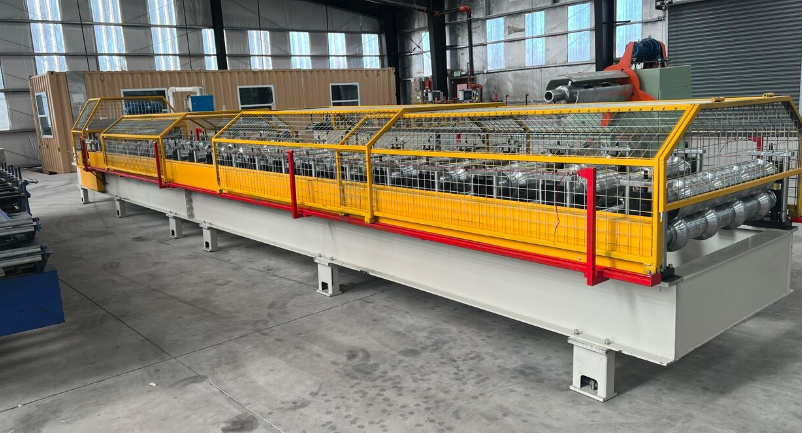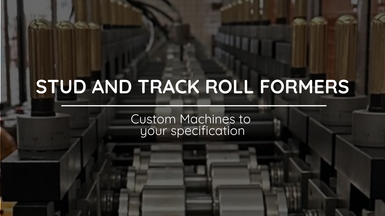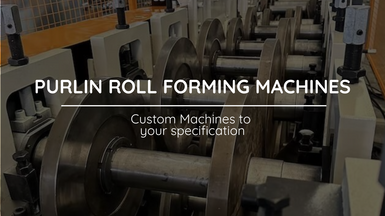
Single or Double Deck Rollformers
Single and double deck rollformers are versatile machines used to manufacture a variety of profiles for metal roofing, siding, decking
Posted on Wednesday, September 18, 2024
Single and double deck rollformers are specialized machines designed for the production of metal panels and roofing profiles. Here's an overview of each:
- Single Deck Rollformers:
- These machines have one set of rollers and are capable of producing one type of profile or panel at a time.
- They are ideal for manufacturers with a focus on a specific product or when switching between different profiles is not frequent.
- Benefits include simplicity, ease of operation, and lower maintenance requirements.
- Double Deck Rollformers:
- Double deck rollformers have two sets of rollers, allowing them to produce two different profiles or panels without the need to change tooling.
- They offer increased efficiency for manufacturers producing multiple profiles since switching between products can be done with minimal downtime.
- This type of rollformer is suitable for high-demand environments where versatility and quick product switching are essential.
Would you like more specific information on features or applications for these machines?
Profiles you can manufacture with a Single or Double Deck Rollformer
Single and double deck rollformers are versatile machines used to manufacture a variety of profiles for metal roofing, siding, decking, and structural applications. Here's a breakdown of common profiles that can be produced with each:
Profiles for Single Deck Rollformer:
A single deck rollformer is usually configured for a specific profile or can be retooled to create different ones. Here are common profiles that can be manufactured:
- PBR Panels:
- Used for roofing and siding, particularly in commercial and industrial buildings.
- Keywords: PBR, roof panel, metal roof panel.
- Standing Seam Panels:
- A popular profile for modern roofing systems, providing a sleek, water-tight seal.
- Keywords: standing seam, standing seam roof.
- Corrugated Metal Panels:
- Often used in agricultural or utility structures.
- Keywords: corrugated metal, corrugated roof panels.
- C or Z Purlins:
- These are structural components used in metal buildings to support roof and wall panels.
- Keywords: C purlin, Z purlin, steel purlin.
- Trim and Flashing Profiles:
- Typically used to provide a finished look and protect the edges of roofing and siding.
- Keywords: roof flashing, metal roof flashing.
Profiles for Double Deck Rollformer:
A double deck rollformer allows the manufacturing of two profiles simultaneously, increasing efficiency and reducing downtime. Common profiles produced with a double deck rollformer include:
- Combination of PBR and B Deck Profiles:
- Both profiles are frequently used for commercial roofing and decking applications.
- Keywords: PBR, B deck, metal decking.
- Metal Roofing and Siding Profiles:
- A combination of standing seam and corrugated profiles can be produced.
- Keywords: standing seam, corrugated panels, metal roof.
- Trim Profiles (e.g., Ridge Cap and Valley Flashing):
- These profiles are often needed alongside standard roof panels.
- Keywords: ridge cap, valley flashing, roof trim.
- Custom Structural Profiles:
- Double deck machines can be designed to produce a custom combination of profiles, including structural and decking profiles.
- Keywords: structural roll forming, deck metal, custom roll forming.
Would you like help choosing the right profiles for your needs or more technical specifications for these machines?
To help you choose the right profiles for your needs with either a single or double deck rollformer, let's consider a few key factors, such as your industry focus, production volume, and the variety of profiles you require.
Factors to Consider:
- Industry Focus:
- Roofing and Siding: If your primary focus is on metal roofing and siding, the most common profiles you'll want to manufacture are PBR, standing seam, corrugated metal panels, and related trims (ridge caps, valley flashing, etc.). These profiles are essential for both residential and commercial roofing.
- Decking and Structural: For commercial and industrial buildings, you may need to produce B deck, C and Z purlins, or other structural profiles like metal decking for floors.
- Custom Applications: If your business focuses on specific custom orders, you may need the ability to manufacture a wide range of profiles, such as custom trims, flashings, or specialized structural components.
- Production Volume:
- Single Deck Rollformers: These are suitable for businesses with lower to moderate production volumes, where the focus is on one profile at a time or occasional changeovers between profiles.
- Double Deck Rollformers: Ideal for high-production environments, especially when you need to switch between two profiles quickly without retooling. For example, you could produce roofing panels on the top deck and structural decking or purlins on the bottom deck.
- Profile Variety:
- If your production involves multiple profiles regularly, a double deck rollformer offers flexibility. You can manufacture a combination of roofing panels like PBR and standing seam on one deck and trim profiles (e.g., flashing or ridge cap) on the other.
- If you manufacture mostly one profile with occasional changeovers, a single deck rollformer could be more cost-effective.
Profile Recommendations Based on Use:
- For Roofing Manufacturers:
- Single Deck Rollformer: You can manufacture PBR panels or standing seam roofing with ease. Additional changeover allows you to switch between profiles like corrugated panels or trim/flashing components.
- Double Deck Rollformer: You can run PBR or standing seam profiles on one deck while manufacturing trim profiles like ridge caps or gutter systems on the second deck simultaneously.
- For Structural Applications:
- Single Deck Rollformer: Focus on producing either C or Z purlins, depending on demand. Retooling allows for easy change between structural profiles.
- Double Deck Rollformer: You can produce both C and Z purlins on one deck and a structural decking profile (like B deck) on the other deck. This combination is great for metal building construction.
- For Custom Profile Manufacturers:
- Single Deck Rollformer: Suitable if you manufacture one-off or low-volume custom profiles, such as specialized trim, flashing, or unique architectural features.
- Double Deck Rollformer: Useful for running multiple custom profiles concurrently, reducing downtime in custom orders and improving overall efficiency.
Recommendations:
- Go with a Single Deck Rollformer if you primarily manufacture one or two profiles with occasional changeovers, and your production volumes are moderate.
- Choose a Double Deck Rollformer if you require high flexibility, frequent profile changes, or high-volume production of multiple profiles (e.g., a combination of roofing panels and structural components).
If you have specific profiles in mind or need more details about technical specs (e.g., rollformer speed, width capacity, material thickness), feel free to share, and I can help with more precise recommendations!
Roll Forming Machines LLC's New Factory
Posted on Sunday, March 23, 2025
We have relocated factories, which will be available for tours very soon.

Uncoiler, Decoiler and Coil Car Roll Forming Machine Accesories from Roll Forming Machines LLC
Posted on Sunday, November 24, 2024
Contact us today with your specifications for a custom Uncoiler, Decoiler or Coil Car at [email protected] or call us at (+1) (407) 859 1119

Stud and Track Roll Forming Machines from Roll Forming Machines LLC
Posted on Saturday, November 23, 2024
Contact us today with your specifications for a custom Stud and Track Machine at [email protected] or call us at (+1) (407) 859 1119

Cee and Zee Purlin Roll Forming Machines from Roll Forming Machines LLC
Posted on Saturday, November 23, 2024
Contact us today with your specifications for a custom Cee and Zee Purlin Machine at [email protected] or call us at (+1) (407) 859 1119